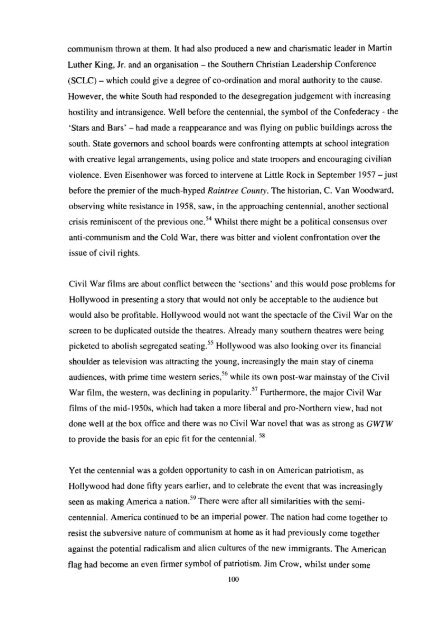Download (3483kB) - Greenwich Academic Literature Archive ...
Download (3483kB) - Greenwich Academic Literature Archive ...
Download (3483kB) - Greenwich Academic Literature Archive ...
- No tags were found...
You also want an ePaper? Increase the reach of your titles
YUMPU automatically turns print PDFs into web optimized ePapers that Google loves.
communism thrown at them. It had also produced a new and charismatic leader in MartinLuther King, Jr. and an organisation - the Southern Christian Leadership Conference(SCLC) - which could give a degree of co-ordination and moral authority to the cause.However, the white South had responded to the desegregation judgement with increasinghostility and intransigence. Well before the centennial, the symbol of the Confederacy - the'Stars and Bars' - had made a reappearance and was flying on public buildings across thesouth. State governors and school boards were confronting attempts at school integrationwith creative legal arrangements, using police and state troopers and encouraging civilianviolence. Even Eisenhower was forced to intervene at Little Rock in September 1957 -justbefore the premier of the much-hyped Raintree County, The historian, C. Van Woodward,observing white resistance in 1958, saw, in the approaching centennial, another sectionalcrisis reminiscent of the previous one. 54 Whilst there might be a political consensus overanti-communism and the Cold War, there was bitter and violent confrontation over theissue of civil rights.Civil War films are about conflict between the 'sections' and this would pose problems forHollywood in presenting a story that would not only be acceptable to the audience butwould also be profitable. Hollywood would not want the spectacle of the Civil War on thescreen to be duplicated outside the theatres. Already many southern theatres were beingpicketed to abolish segregated seating. 55 Hollywood was also looking over its financialshoulder as television was attracting the young, increasingly the main stay of cinemaaudiences, with prime time western series, while its own post-war mainstay of the CivilWar film, the western, was declining in popularity. 57 Furthermore, the major Civil Warfilms of the mid-1950s, which had taken a more liberal and pro-Northern view, had notdone well at the box office and there was no Civil War novel that was as strong as GWTWto provide the basis for an epic fit for the centennial. 58Yet the centennial was a golden opportunity to cash in on American patriotism, asHollywood had done fifty years earlier, and to celebrate the event that was increasinglyseen as making America a nation.59 There were after all similarities with the semi-centennial. America continued to be an imperial power. The nation had come together toresist the subversive nature of communism at home as it had previously come togetheragainst the potential radicalism and alien cultures of the new immigrants. The Americanflag had become an even firmer symbol of patriotism. Jim Crow, whilst under some100
















